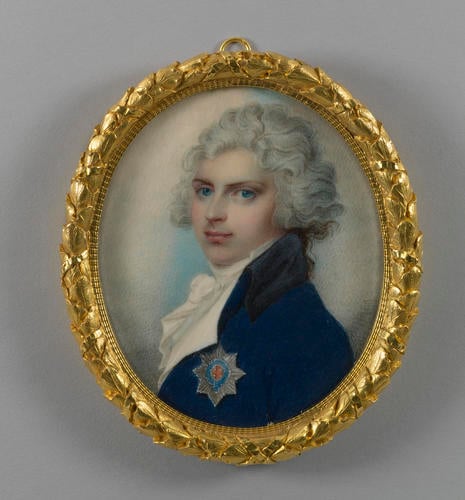Augustus Frederick, Duke of Sussex (1773-1843) c.1791
Watercolour on ivory | 7.2 x 6.1 cm (sight) (sight) | RCIN 420973
-
Prince Augustus is depicted wearing the star of the Order of the Garter. This portrait is a variant of a miniature of the Prince depicting him in Windsor uniform (court dress introduced by George III in 1779), which is enclosed in a case bearing the royal crest, the motto of the Order of the Garter, and the Prince's initials A.F. The miniature by Richard Cosway originally belonged to the sitter's nephew, the Duke of Cambridge and was sold on his death in 1904.
Prince Augustus Frederick, Duke of Sussex (1773–1843), was the sixth son and ninth child of George III and Queen Charlotte. From 1786, when he entered the University of Göttingen, Germany, until 1804, he mostly resided abroad. When living in Rome, he met and secretly married the Catholic Lady Augusta Murray in 1793. This contravened the provisions of the Royal Marriages Act of 1772, and the marriage was declared void by the King in August 1794. They had two children. In 1801, Prince Augustus was created Duke of Sussex, Earl of Inverness and Baron Arklow. He became estranged from his father and the court because of his liberal political views. He supported the abolition of the slave trade, Catholic emancipation, the removal of civil restrictions on Jews and dissenters, the abolition of the Corn Laws, and parliamentary reform. He was elected President of the Society of Arts in 1816, and from 1830-8 was President of the Royal Society. Duke Augustus built up a large library of over 50,000 volumes, including about 1,000 editions of the Bible, and many ancient manuscripts. In 1831, he married Lady Cecilia (1793–1873), daughter of the second Earl of Arran. When he died, The Times commented that 'No death in the royal family short of the actual demise of a monarch could have occasioned a stronger feeling of deprivation'. In his will, he asked that his remains should not be interred with the royal family at Windsor, and he was buried in the public cemetery at Kensal Green.
It has been suggested that the artist may be Maria Cosway (1759/60-1838). She was born in Italy, as Maria Hadfield, the daughter of an Irish hotel keeper. She studied art in Rome and became a member of the Academy in Florence in 1778. In 1779, after her father's death, she travelled to England and found work as a miniaturist. She married Richard Cosway in 1781 and they had one daughter, Louisa Angelica (1789-96) who died very young. Maria exhibited at the Royal Academy from 1781-9, showing history paintings and portraits. From the 1790s onwards Cosway spent most of her life in France and Italy, establishing schools for women in Lodi and Lyon. She died in Lodi, Italy in 1838.Provenance
Possibly painted for George IV, when Prince of Wales, c. 1791 -
Creator(s)
-
Medium and techniques
Watercolour on ivory
Measurements
7.2 x 6.1 cm (sight) (sight)
8.7 x 7.7 cm (frame, external)
Category
Object type(s)
Other number(s)
Cust 1910 : Cust, L., 1910. Windsor Castle: Portrait Miniatures, London – Cust 1910 III/157RL 1870 11.B.4Alternative title(s)
William, Duke of Clarence, later William IV (1765-1837), previously identified as








